Ikebana is a masterful form of arranging flowers that originates in Japan. It focuses on minimalism and character, though it may be a little harder to master than other ways of arranging flowers. This guide will cover the basic principles of the art that are shared between the various schools of ikebana.
There are many guiding principles to ikebana, and they include minimalism, graceful shapes, a form that is found and not planned, and a three-pointed structure. The three-pointed nature of ikebana is used to represent humanity, the earth, and heaven.
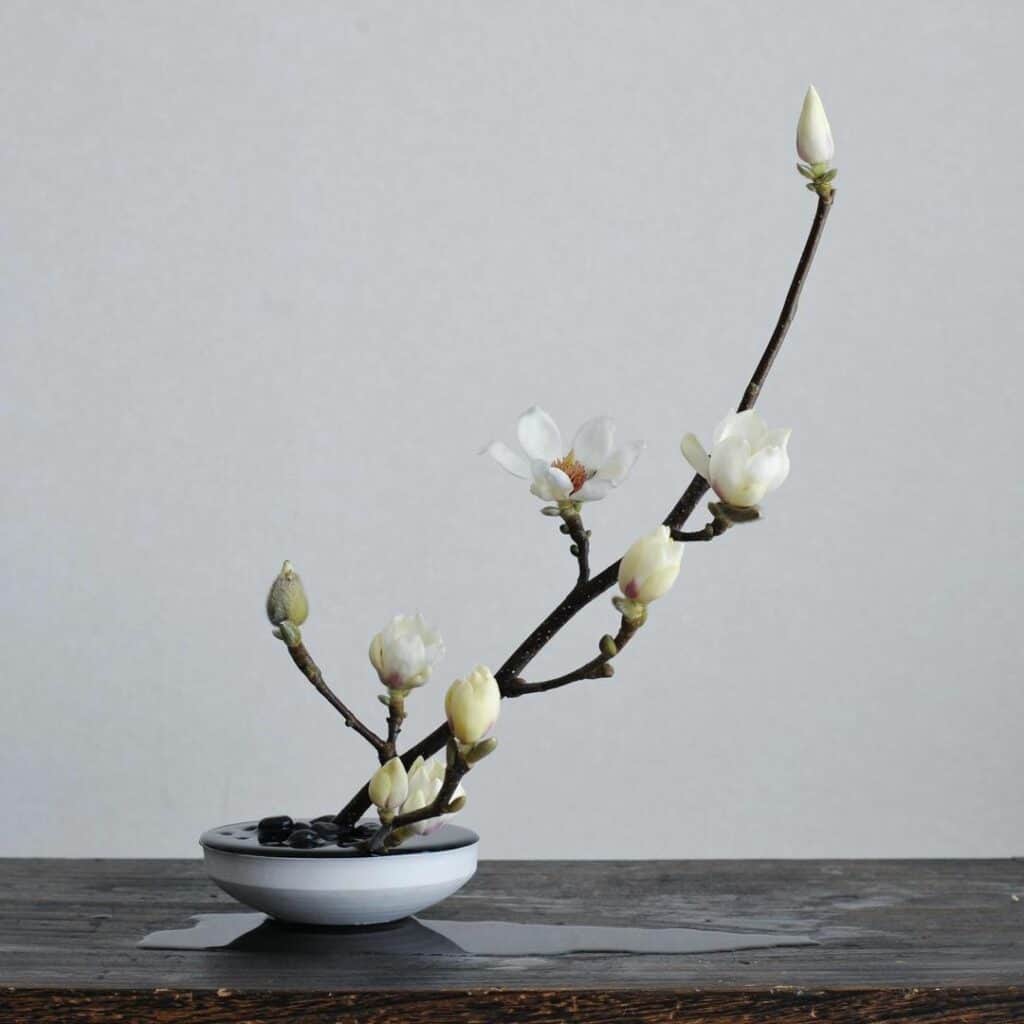

There’s a lot to unpack about ikebana that we simply can’t sum up in a few lines of text, so we’ll be diving into exactly how an ikebana arrangement differs from a simple bouquet of flowers. We’ll also take a closer look at these fundamental principles that influence people who practice ikebana.
The Overriding Principles of Ikebana
Here are some of the main underlying philosophies in Ikebana flower arrangement:
- Representing the artist’s personality through nature
- The use of lines formed by plant stems
- Using flowers as focal points
- Abiding by the concept of minimalism
- A three-pointed structure
- A found form instead of one that was created
- Seasonal appearance
- Removing elements instead of adding them
A Representation of the Personality
Ikebana is meant to be a union of nature and humanity, and you’ll find that this is a repeating theme throughout the art form. Being able to replicate your personality through the use of plants, within the confines of ikebana is the sign of a true master of the art.
For example, someone who is serious and dire may wish to replicate this part of their personality through harsh, abrupt lines that give the viewer a sense of order. If someone has an artistic flair and a more chaotic personality, this will be reflected in a busier ikebana arrangement, potentially incorporating clashing colors.
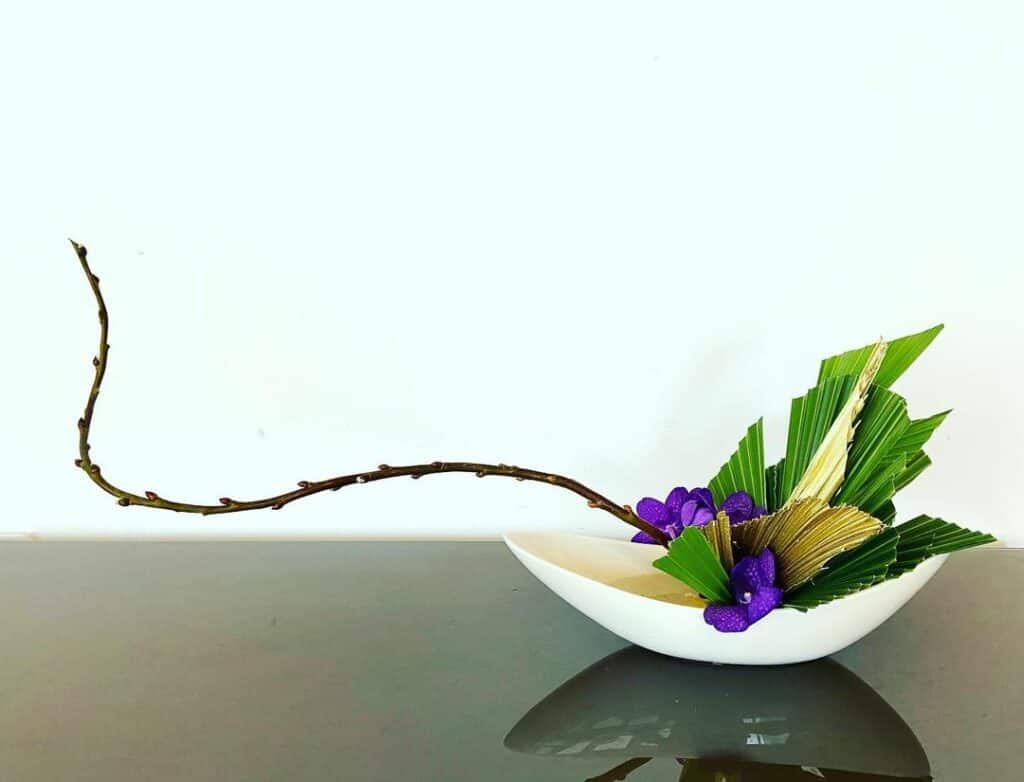
The thing about ikebana is that you can make it your own as long as you retain the teachings of the art form in your work. That being said, there is sufficient freedom in an ikebana arrangement to represent yourself, and many of the guidelines in practicing this form of art aren’t hard and fast rules.
Humanity is a concept that is ever-present in ikebana, as it’s one of the three concepts that this form of flower arrangement is made to represent.
However, ikebana is also about finding an existing shape in nature and helping to bring it out. To create the harmony that masterful ikebana displays are known for, you can’t fight against the plant to create something that you want to see in it.
Instead, you need to take a long look at the plants you’re using and get an idea of the beauty that you can create by working with the plants instead of against them.
Don’t forget that selecting the right plants is a foundational element of ikebana. Much like the flowers in a western bouquet are dependent on the message that you want to send, the same can be said of the plants used in ikebana.
For example, you can use flowering buds to represent your growing love for someone in your life. Ikebana is also versatile enough to be used to represent sadder occasions.
Always remember that ikebana is a reflection of yourself.
Ikebana and Lines
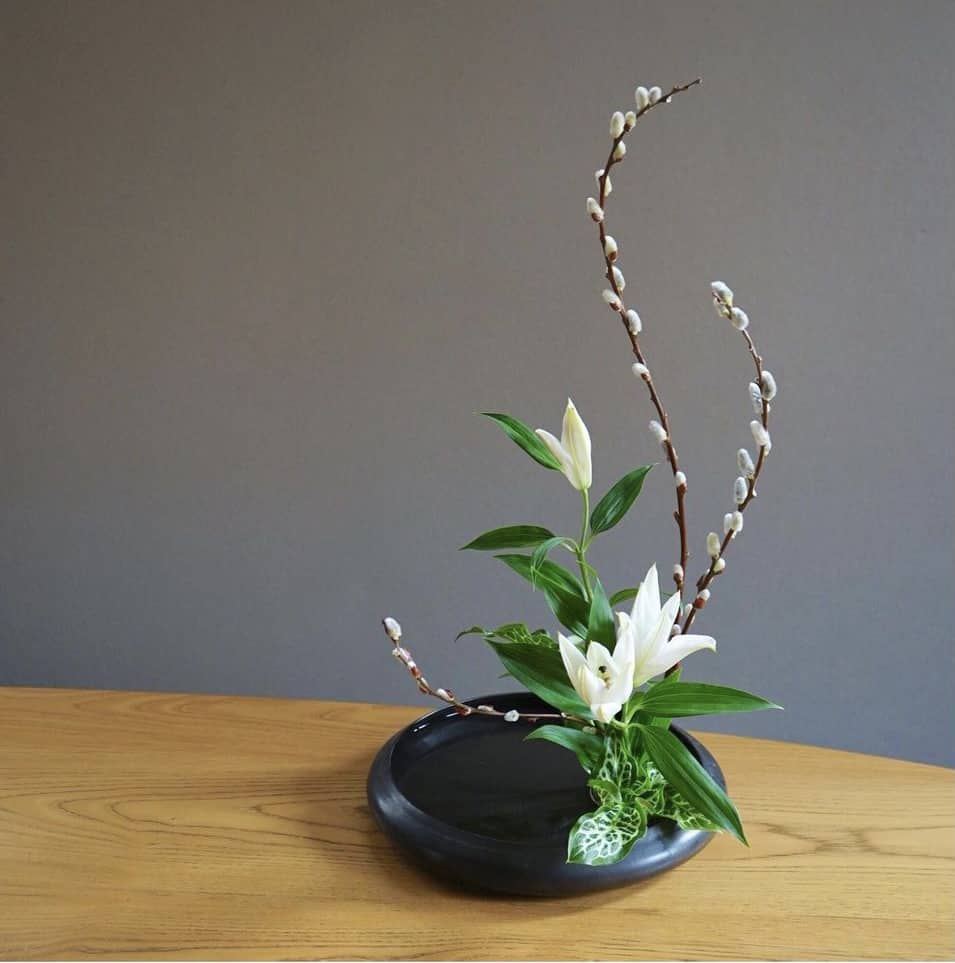
The branches and stems of the plants that you use in your ikebana arrangement are arguably more important than the flowers themselves. While the flowers are meant to draw the viewer’s attention, the lines formed by these stems and branches help bring the entire arrangement together.
While ikebana is meant to be minimalist, this doesn’t necessarily mean that you should use a minimal number of plants. In fact, there is a happy medium between a minimal arrangement and one that is overcrowded. While this may be difficult to see for a first-timer, it becomes more obvious as you start to master ikebana.
Lines are used in ikebana to establish the kind of emotion and feeling that you wish to create in your floral arrangement. For example, if you want to give the viewer a feeling of movement, you may wish to create lines that flow in a certain direction, with a more asymmetrical appearance.
On the other hand, to create a feeling of being static, your lines should mostly be vertical or horizontal, with fewer diagonal stems that give the impression of movement.
Verticality also plays a crucial role in ikebana, and it is seen as lending strength to a floral arrangement. This is especially true if the flower stems are pointing straight up without being bowed by the force of gravity.
Flowers and Focus
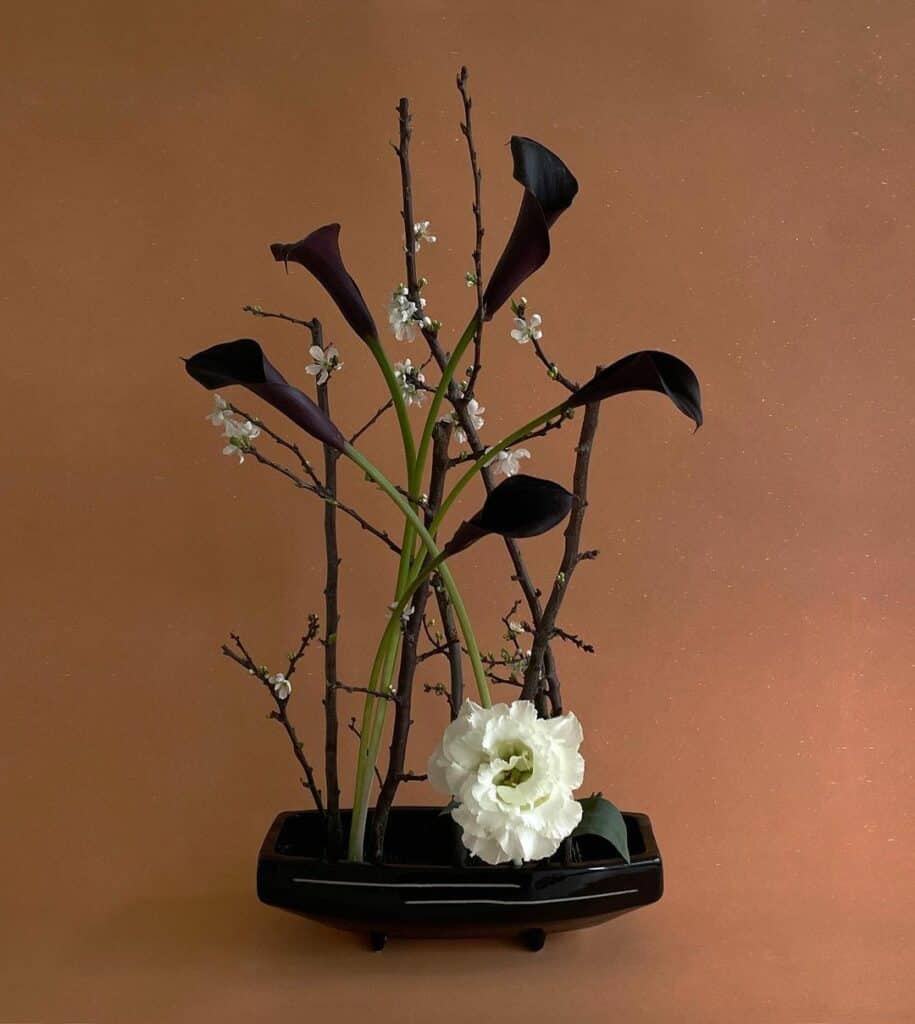
When you’re creating an ikebana arrangement, you want to determine where people will focus when they look at it, as with any other work of art. While stems play a huge role in determining the lines that create a sense of movement in your ikebana arrangement, flowers are like the cherry on top.
Since our eyes have a tendency to focus on things that are bright and colorful, especially if they’re relatively isolated, flowers are the best way to focus the viewer’s attention. The number of flowers in an ikebana arrangement is dependent on the season and the message that you would like to send.
Flowers aren’t the only thing that you can use to create a focal point while practicing ikebana, as you’ll also have to become a master of positive and negative space. Negative space is an area that intentionally has nothing in it, serving to temper a viewer’s attention by balancing focal points.
There is also positive space, which is space that is occupied by plant matter in an ikebana arrangement. By creating a balance between the positive and negative space in your ikebana arrangement, you have some degree of control over where an observer will look when they first see it.
Ikebana and Minimalism
Ikebana was developed using the Buddhist principle of minimalism, meaning that you shouldn’t use additional elements in your arrangement unless they have a reason to be there. This also means that you shouldn’t use too many different types of plants when creating an ikebana arrangement.
When you combine too many different species of plants in a single arrangement, they begin to clash with each other, diminishing the value of the arrangement as a whole. As a starting guideline, you’ll want to stick to between two and three plant types in a single arrangement.
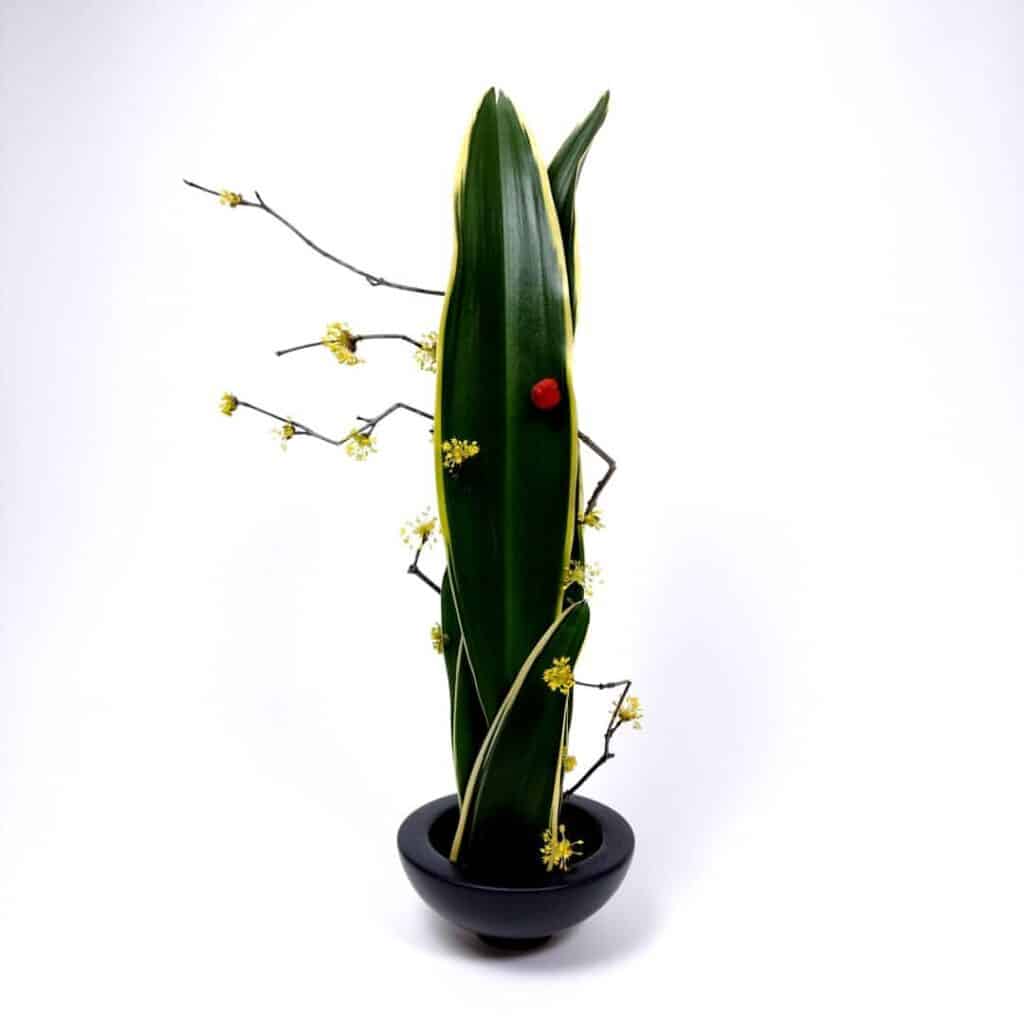
While you can use more than three plants, being able to insert them into an arrangement gracefully is a skill that typically comes with time. Along with employing minimalism in the selection of your plants when practicing ikebana, you’ll want the arrangement to look minimalist, as well.
Even using a single type of plant, it’s possible to create an ikebana arrangement that looks overcrowded or lopsided (though keep in mind that this is sometimes the intent).
When you’re just getting started with ikebana, try not to worry too much about a lack of minimalism in your presentation. The most important part of this discipline is to be able to bring out what you want to see in a plant, and most other concerns should be secondary until you can manage that.
The Three Points of Ikebana
While this isn’t a hard and fast rule, many ikebana arrangements incorporate a triangular structure. More specifically, the shape tends to be that of a scalene triangle, in which each side has a different length. These three sides represent three ideals: humanity, heaven, and earth.
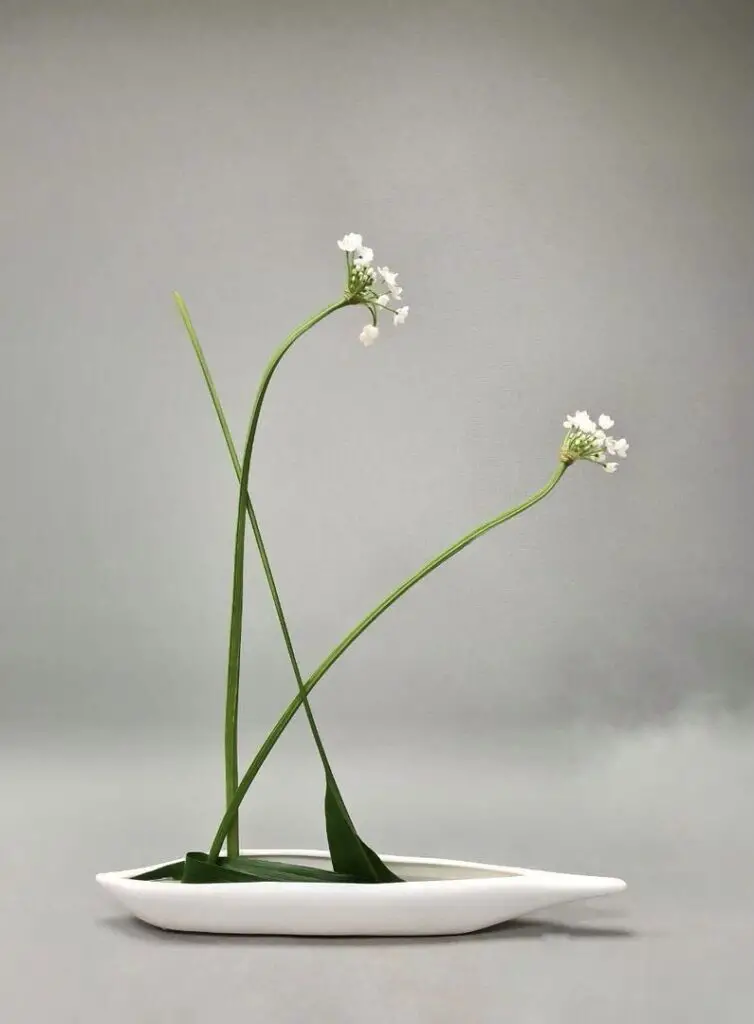
Each side is a different length because of the inherent differences between those three aspects. However, since humanity, heaven, and the earth all share a common bond, they are connected through the floral arrangement that they’re all a part of. Ikebana represents this delicate union between these three forces.
How you create a three-sided arrangement is entirely up to you, but most beginners will do so by using twigs, branches, or stems. Keep in mind that the three sides of the triangle don’t necessarily have to be directly connected to one another, as you can take a more abstract approach.
Even if you just strategically prune the leaves on your ikebana arrangement, you can form a triangular shape that represents these three points. Like with many things in ikebana, you aren’t expected to immediately grasp the concept, but rather gradually develop it as you begin to master the art.
The Importance of Finding Your Arrangement’s Form
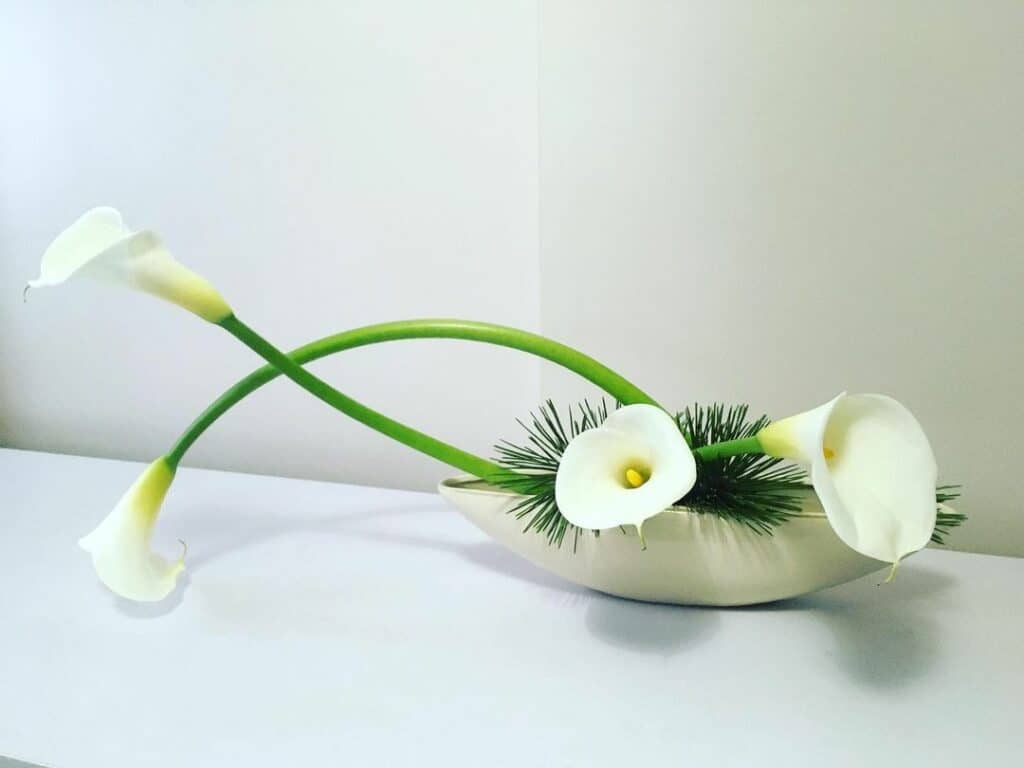
While it may sound counterintuitive, the last thing that you want to do before getting started on an ikebana arrangement is planning it. If you try to plan out one of these arrangements, then you’re doomed to fail, as an essential part of practicing ikebana is working with the plants to find a shape that already exists in them.
Instead of drawing out an idea of how you’d like your arrangement to end up, decide on a few species of plants and start experimenting with them. Get yourself a vase and start coupling different plants with each other to see if any of them click.
If you like the look of a particular pairing, then you can start pruning and clipping so that you can bring out the form that you see lying beneath the untrimmed branches of your arrangement. It’s essential to look at your arrangement with an artistic eye to see what you can create by working with the plant, instead of against it.
This also means that you don’t want to make many drastic changes to the appearance of the plants used in your ikebana arrangement (similarly to when you’re creating a kokedama plant). While you may have an idealized view of how the arrangement should end up, there are times when the plant may not cooperate with you and you’ll have to find an alternative approach.
Keeping Your Ikebana Arrangement Seasonal
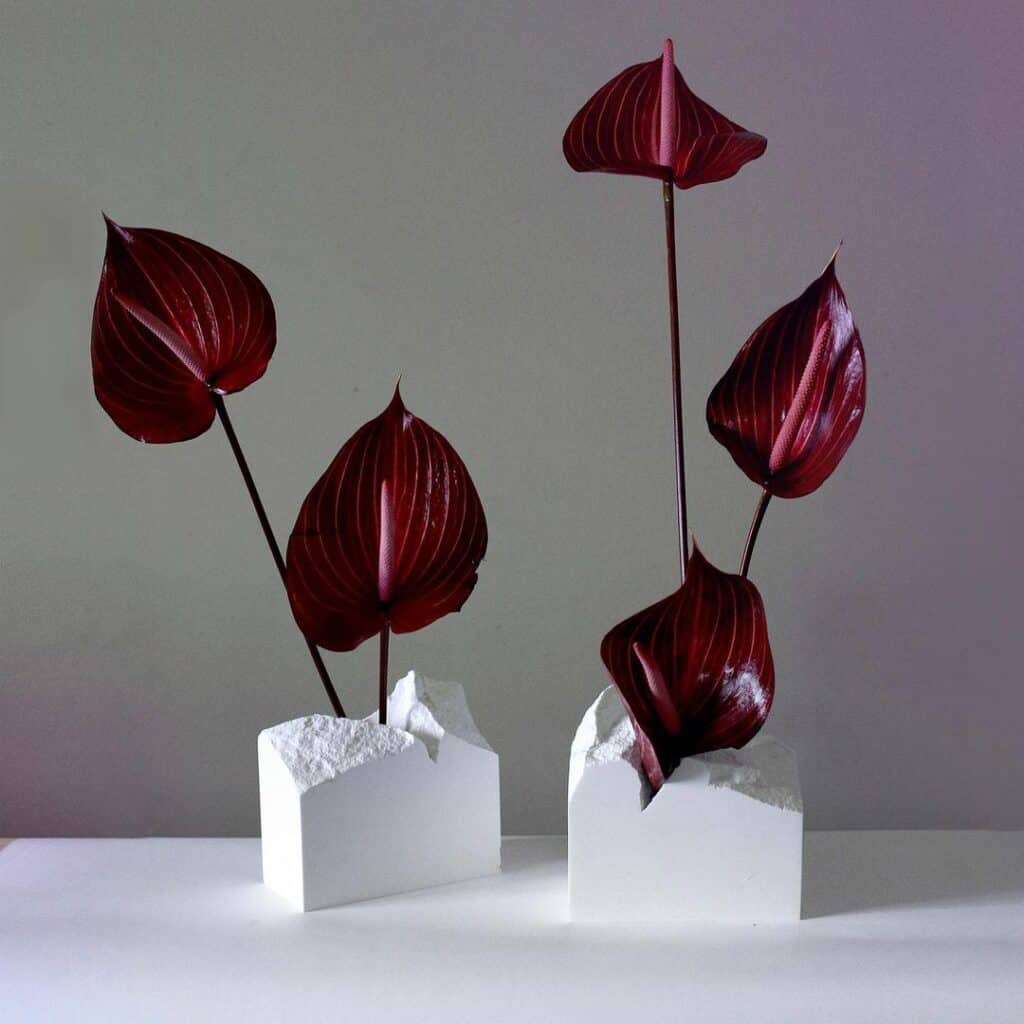
Ikebana also represents the current season, as all plants tend to. This is especially true because you’re expected to forage for the plants that you use in an ikebana arrangement yourself. While you can certainly buy plants to create an arrangement, you should still focus on plants that are in season if you find yourself doing so.
Many ikebana practicers combine this hobby with their love of the outdoors, heading out for walks and hikes on which they find the materials that they’ll use in their next arrangement. Of course, you’ll want to have at least a basic level of knowledge about the plants that you’ll come across in your walks.
The last thing you want to do is bring back a branch of poison ivy to include in your ikebana arrangement. If you don’t recognize a plant, bring along your smartphone and research it on the go. For those who don’t have data, you can always snap a photo of a plant and then research it when you return home.
You can even gather materials for ikebana from your own backyard. In fact, many ikebana practicers tend to a garden so they can have an easily-accessible source of materials for future arrangements.
Always Remove, Never Add
Keeping with the principles of minimalism, you want to typically avoid adding any elements to an ikebana arrangement after you’re done selecting the initial plants that you’ll be working with. Once the selection process has been completed, your job is now to remove any unnecessary features.
Ikebana is often compared to sculpting, and with good reason. A sculptor starts with a block of marble from which they remove elements that don’t belong. You’re unlikely to ever see a sculptor adding an additional piece of marble to create a work of art.
The amount that you should remove from an arrangement is entirely dependent on the size of your vase and what you’re trying to bring out of the plants. Arrangements that use smaller vases should be no more than ¼ full, so if you’re not looking to remove a significant number of leaves and branches, opt for a larger vase.
